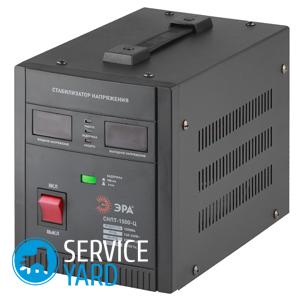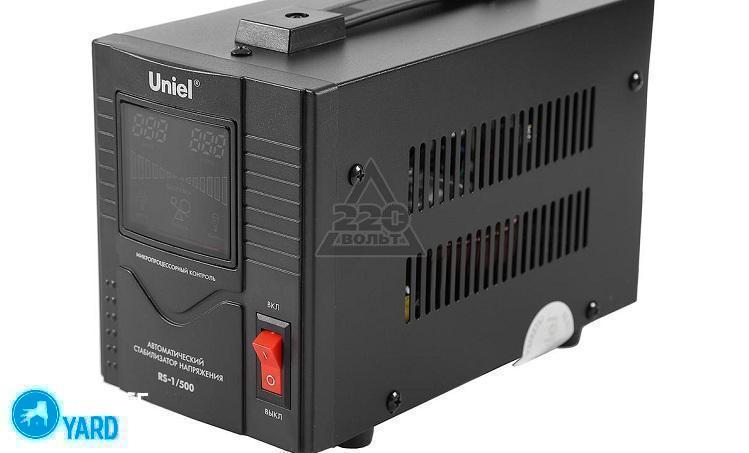How to choose a voltage stabilizer for a private house and apartment?

Anyone at least once in his life has encountered problems associated with power surges, but they don’t cause any problems to anyone, and other people have expensive equipment that fails. Often, living in the country is accompanied by such unpleasant moments as power surges, and they seriously spoil life. Neither crystal clear air nor nature's charming beauty will help here. And this can become a global problem, because modern appliances and household appliances are excessively demanding on stable voltage and immediately refuse to work if something goes wrong. You should not expect any help from the state in such a situation - it is better to solve the problem yourself by purchasing a special device. Therefore, in this article we will talk about how to choose a voltage stabilizer for a private house or apartment yourself.
to contents ↑The principle of operation of stabilizers and their varieties
This information will undoubtedly be useful to you in taking the first step towards solving the problem of constant power outages. There are three types of such devices, and in order to understand how to choose a voltage stabilizer for your case, you need to briefly consider all the varieties.
Relay stabilizers
The principle of operation of such a device can be understood even by a student who studied physics and is familiar with the transformer. Relay stabilizers give the voltage of the desired value by changing the number of turns of the secondary winding. Depending on which specific direction the voltage in the coil of the primary transformer relay fluctuates, it changes the number of turns in the second coil. Due to this, we get a sufficient and stable voltage at the output. These devices have more pros than cons.
Benefits:
- Affordable price.
- Service life not less than 10 years.
- Resistant to any overload.
- Do not make noise during work.
- Work with the lowest and highest voltage.
- The devices are compact in size.
Important! Disadvantages:
- Not too fine adjustment accuracy, approximately 8%.
- The voltage changes in stages, which can be observed on an incandescent lamp.
Servo stabilizers
They work on the same principle as relay, but instead of a relay they are equipped with a special electric motor with a servo drive.
Pros:
- Affordable cost.
- The highest degree of accuracy of voltage regulation.
Disadvantages:
- Slow response to network surges, delay of approximately 1-2 seconds.
- Short service life due to the presence of movable elements.
- Too noisy.
Important! It is better not to use them in houses with high inductive voltage, where it is full of large equipment, since from the side a delay of several seconds may seem like a trifle, but for sensitive equipment this is a huge danger. Such stabilizers place in houses with a small number of household appliances.
Electronic stabilizers
This type of device is the most modern, as it was created taking into account the requirements and requirements of new technology. Here, triacs or electronic thyristors are responsible for controlling the voltage drops, and not outdated servomotors or relays.
They react to voltage changes simply instantly, which means that household appliances are under maximum protection. Moreover, the more the stabilizer has adjustment levels, the more accurate and better it will maintain the required voltage level.
to contents ↑Important! They work very long and absolutely quiet. They are expensive, but their price is fully justified.
How to choose a voltage stabilizer for a private house?
There is a large list of recommendations regarding how to choose a voltage regulator for a summer house or a private house, but the main thing is to learn how to read the instructions that came with the device. You need to pay attention to such moments:
- Power.
- Number of phases.
- How long does it take for the device to respond to power surges.
- The maximum and minimum voltage limits that must be closely monitored, since when they are reached, the device does not work.
- The recommended installation option is floor or wall.
- Output voltage indicated with precision adjustment.
Particular attention should be paid to the selection of power of the selected device. It is not difficult to do this if you follow the instructions:
- Studying its active power, which is indicated in the instructions, you need to remember about the reactive power that occurs when there is inductance due to devices with the most powerful electric motors. If this moment is not taken into account, then the stabilizer will not be able to overcome the maximum load of the network when starting the device.
- Transformation ratio. When the network produces a voltage of 220V, the device passes it freely through itself and transfers it to all electrical appliances without processing. At this moment, this coefficient is zero. But if the voltage coming from the network deviates up or down, then the stabilizer equalizes it to 220V, while the power is lost.
to contents ↑Important! If you plan to protect only one device from differences, then you can purchase a stabilizer exclusively for it. If the house has a lot of sensitive and expensive appliances, it will be more rational to buy a 220V stabilizer for the house, which can fully service the entire living area. Due to this, you will not experience any inconvenience when using your equipment.
Rules for choosing a voltage stabilizer for an apartment
In principle, it is not difficult to answer the question of how to choose a voltage stabilizer for an apartment, since we have already found out certain points. When buying this device for installation in an apartment, consider the following factors:
- Single phase or three phase. It is not difficult to determine this criterion, you just need to consider which network your house is connected to and whether there are appliances in the apartment that work from three phases.
- Wall or floor. The first option will cost more, but such stabilizers take up very little space. But the floor ones are inexpensive, but the inconvenience is caused by wires constantly getting under your feet.
- Power. As in the case of a private house, it is necessary to take into account the number of appliances and household appliances in the apartment, their total capacity. It is also important to take into account the voltage in the electrical panel.
- Accuracy. Remember, the less errors will occur during the operation of the device, the better the acceptable threshold.
- Type of stabilizer. There are several varieties of them: electronic, ferroresonant, mechanical and compensatory.
- The material of which the housing is made. It is better to prefer a metal model, since it is stronger and more reliable.
- Cost. This is a rather important factor, which in many cases is crucial.
Stock footage
That's all you need to know to choose a voltage regulator for a private home. Once again, review all the recommendations, and then go to the store to choose the device that suits you. And install it yourself or with the help of a wizard - decide when the stabilizer is already in your hands.
- How to choose a vacuum cleaner taking into account the characteristics of the house and coatings?
- What to look for when choosing a water delivery
- How to quickly create comfort at home - tips for housewives
- How to choose the perfect TV - useful tips
- What to look for when choosing blinds
- What should be running shoes?
- What useful things can you buy in a hardware store
- Iphone 11 pro max review
- Than iPhone is better than Android smartphones




